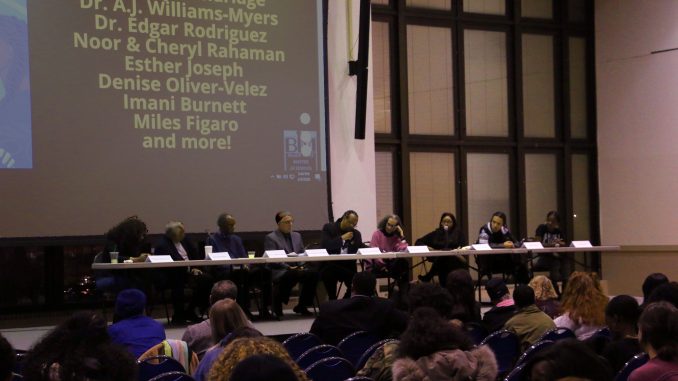
Do you know why the Shango dorms are named ‘Shango?’ Do you know how to correctly pronounce the name? Chances are, you’ve been pronouncing it wrong and don’t know the powerful reason for the building’s name.
In the late 1960s, a portion of College Hall was transformed into the Shango dormitories, which then served as a living and learning residence where students of color could safely and proudly celebrate their culture in solidarity. Hence the Malcolm X mural in the dorm.
The name Shango is in honor of the Nigerian religion, Yoruba. Shango is a powerful Yorubian god of thunder who students selected to represent and be a protective presence over their dorms. Contrary to a seemingly popular campus belief, it’s pronounced shanGŌ, not SHANgo.
The reason why many do not know this story is because the majority of current students do not often get the opportunity to connect with what this campus was like decades ago. But at the event, “The Black Struggle for Justice at SUNY New Paltz: Past, Present & Future,” students were given an opportunity to do exactly that.
The event, which kicked off a series of Black History Month events at SUNY New Paltz, consisted of a 30-minute portion for refreshments at 5:30 p.m., followed by a panel. Panelists consisted of current and previous students of color whose ages ranged from 21 to 72. Each panelist provided unique yet powerful experiences which helped begin to paint the picture of what their experiences on campus were like.
There was no shortage of enlightening stories. The radical Prof. Denise Oliver-Velez taught audience members about the history of Shango and said she “became a Black Panther because I thought communism was boring.” Dr. Edgar Rodriguez spoke about the revolt of the academic year of 1983-1984 when people of color joined together and created a 10-page list of demands for the administration to adhere to.
The generational difference in experiences was evident in the conversation about what each person was doing when they found out Martin Luther King, Jr. had been assassinated. Dr. A.J. William-Myers said the news “tore us apart.”
Though current students could not relate to what campus was like when Dr. King was assassinated, they did discuss the gloom and fear that saturated the campus when President Donald Trump was elected in 2016. A pinnacle of white supremacy and bigotry had risen to one of the most powerful positions in the world, to the surprise and dismay of many.
People were hurt and afraid, especially for immigrants in the community who were unsure what their future would hold. Further, racial slurs were scrawled on bathroom walls following the election, amplifying the fear and anger.
But students noted how many fellow students of color on campus, even those who did not know each other, were there for each other.
Miles Figaro, fourth-year student and president of the Black Student Union, remembers students stopping to comfort people who were down or walk with them back to their dorms to help them feel safer.
Fourth-year student Esther Joseph said, “I can say something about the Black community here. We do lean on each other for support.”
Despite differences that each panelist could not personally relate to, there are things that resonated consistently, regardless of the year. One is the support of the Black community. Another is students of color being told by counselors that they wouldn’t amount to anything.
William-Myers, class of 1979, says his teacher in eighth grade pulled him aside and advised him to focus on going to a trade school instead of staying in school. She said trade school would fit better with the line of work ‘his people’ are more fit to do. Over 40 years later, William-Myers is proud he didn’t listen to this teacher. He now has a PhD.
Multiple current students shared experiences of teachers in middle and high school telling them to drop out of school and pursue something else because they weren’t good enough. Teachers failing to see the potential brimming in their students of color unfortunately proves to be a timeless and common experience.
This consistent struggle and discrimination is why Oliver-Velez reminded the audience, “We still have alot of struggle to do. The power of our ancestors is with us, right here all the time.”

